Analysis and Strategies for Improving Bellevue Cleaners Performance
VerifiedAdded on 2023/04/21
|46
|10007
|62
Report
AI Summary
This report provides a comprehensive analysis of Bellevue Cleaners Ltd, a dry cleaning and laundry specialist in London, focusing on strategies to improve its business performance. The analysis includes an evaluation of the company's operational strategy, financial performance, and existing problems such as long queues, poor quality of laundry services, and high return rates for alterations. Various investment appraisal methods, including Payback Period and Net Present Value, are used to assess the suitability of proposed improvements. The report also discusses the Hayes and Wheelwright model to understand the company's operational capabilities and suggests solutions like implementing a self-drop-off machine, opening a new processing shop, and improving alteration services with new equipment and a fitting area. The Performance-Importance matrix is used to prioritize improvements based on customer needs and business impact, ultimately aiming to enhance customer satisfaction and gain a competitive advantage.
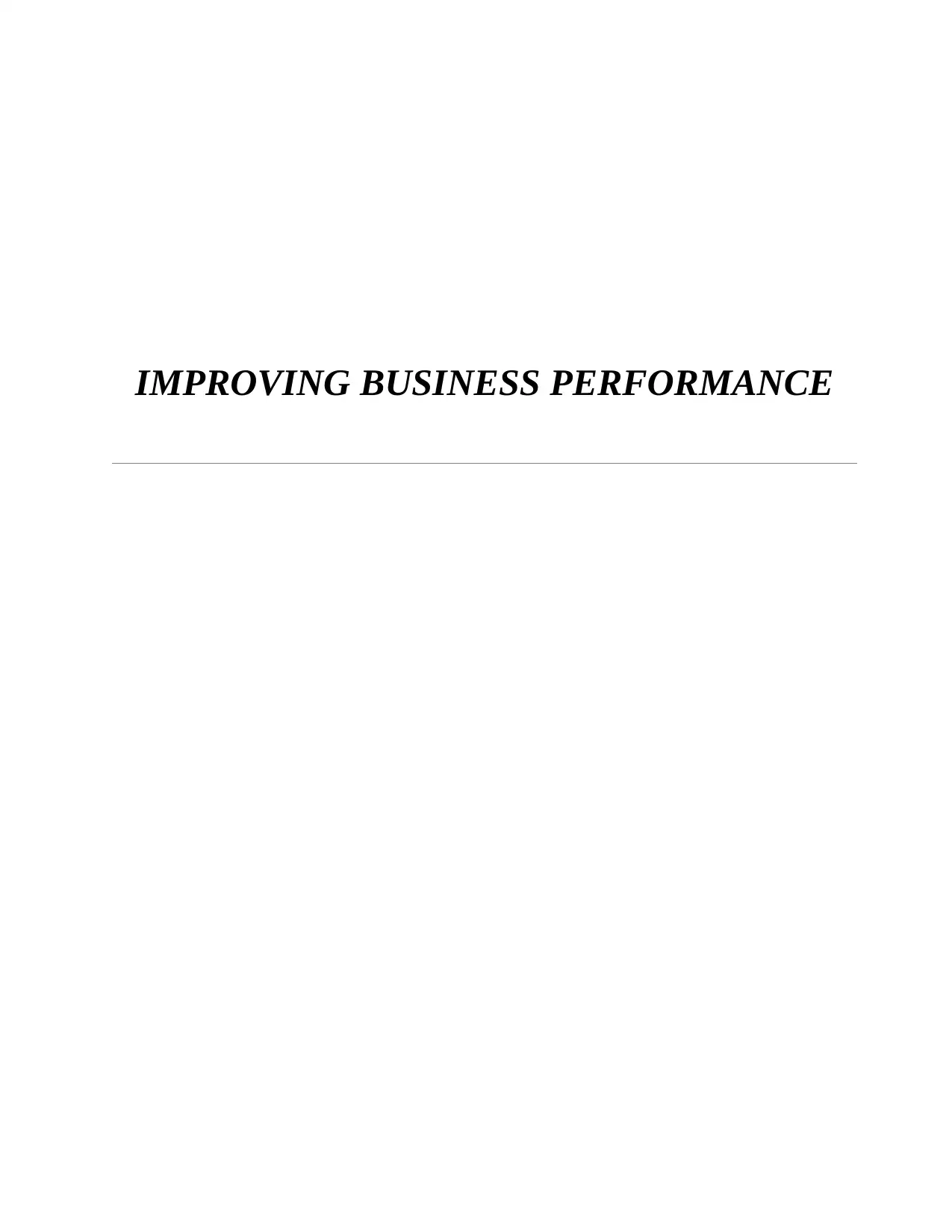
IMPROVING BUSINESS PERFORMANCE
Paraphrase This Document
Need a fresh take? Get an instant paraphrase of this document with our AI Paraphraser

TABLE OF CONTENTS
Executive summary……………………………………………………………………..
Improving business performance report
Executive summary……………………………………………………………………..
Improving business performance report
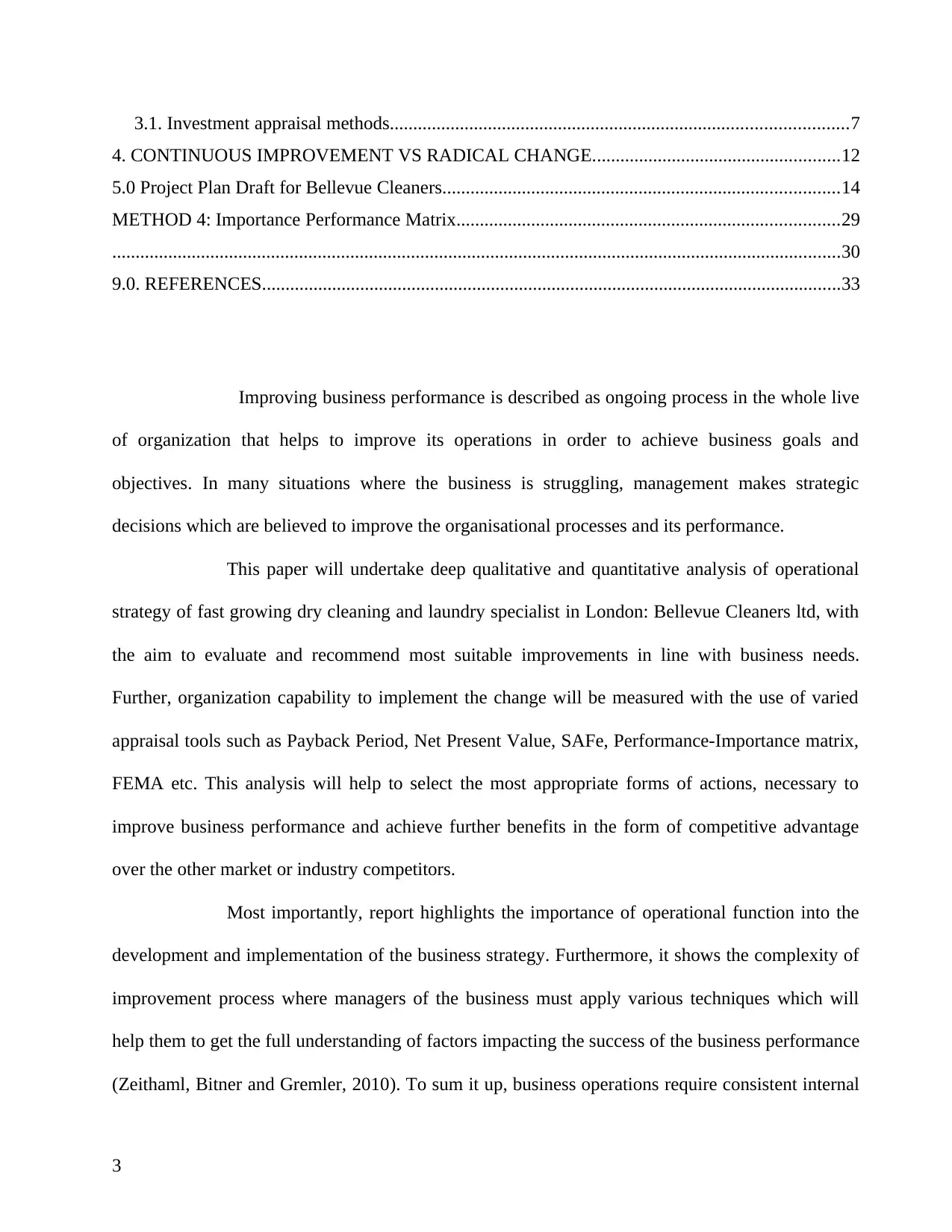
3.1. Investment appraisal methods..................................................................................................7
4. CONTINUOUS IMPROVEMENT VS RADICAL CHANGE.....................................................12
5.0 Project Plan Draft for Bellevue Cleaners.....................................................................................14
METHOD 4: Importance Performance Matrix..................................................................................29
............................................................................................................................................................30
9.0. REFERENCES............................................................................................................................33
Improving business performance is described as ongoing process in the whole live
of organization that helps to improve its operations in order to achieve business goals and
objectives. In many situations where the business is struggling, management makes strategic
decisions which are believed to improve the organisational processes and its performance.
This paper will undertake deep qualitative and quantitative analysis of operational
strategy of fast growing dry cleaning and laundry specialist in London: Bellevue Cleaners ltd, with
the aim to evaluate and recommend most suitable improvements in line with business needs.
Further, organization capability to implement the change will be measured with the use of varied
appraisal tools such as Payback Period, Net Present Value, SAFe, Performance-Importance matrix,
FEMA etc. This analysis will help to select the most appropriate forms of actions, necessary to
improve business performance and achieve further benefits in the form of competitive advantage
over the other market or industry competitors.
Most importantly, report highlights the importance of operational function into the
development and implementation of the business strategy. Furthermore, it shows the complexity of
improvement process where managers of the business must apply various techniques which will
help them to get the full understanding of factors impacting the success of the business performance
(Zeithaml, Bitner and Gremler, 2010). To sum it up, business operations require consistent internal
3
4. CONTINUOUS IMPROVEMENT VS RADICAL CHANGE.....................................................12
5.0 Project Plan Draft for Bellevue Cleaners.....................................................................................14
METHOD 4: Importance Performance Matrix..................................................................................29
............................................................................................................................................................30
9.0. REFERENCES............................................................................................................................33
Improving business performance is described as ongoing process in the whole live
of organization that helps to improve its operations in order to achieve business goals and
objectives. In many situations where the business is struggling, management makes strategic
decisions which are believed to improve the organisational processes and its performance.
This paper will undertake deep qualitative and quantitative analysis of operational
strategy of fast growing dry cleaning and laundry specialist in London: Bellevue Cleaners ltd, with
the aim to evaluate and recommend most suitable improvements in line with business needs.
Further, organization capability to implement the change will be measured with the use of varied
appraisal tools such as Payback Period, Net Present Value, SAFe, Performance-Importance matrix,
FEMA etc. This analysis will help to select the most appropriate forms of actions, necessary to
improve business performance and achieve further benefits in the form of competitive advantage
over the other market or industry competitors.
Most importantly, report highlights the importance of operational function into the
development and implementation of the business strategy. Furthermore, it shows the complexity of
improvement process where managers of the business must apply various techniques which will
help them to get the full understanding of factors impacting the success of the business performance
(Zeithaml, Bitner and Gremler, 2010). To sum it up, business operations require consistent internal
3
⊘ This is a preview!⊘
Do you want full access?
Subscribe today to unlock all pages.

Trusted by 1+ million students worldwide
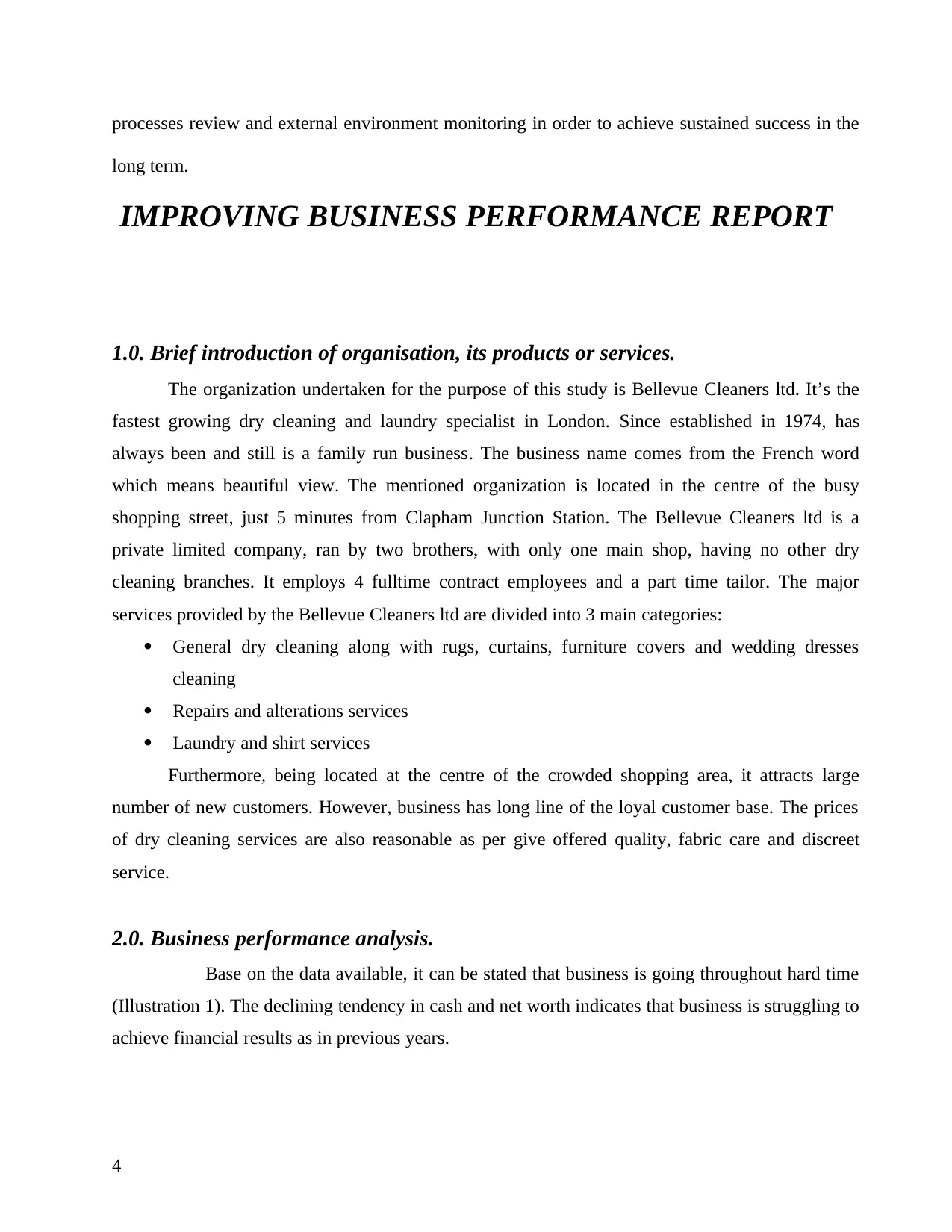
processes review and external environment monitoring in order to achieve sustained success in the
long term.
IMPROVING BUSINESS PERFORMANCE REPORT
1.0. Brief introduction of organisation, its products or services.
The organization undertaken for the purpose of this study is Bellevue Cleaners ltd. It’s the
fastest growing dry cleaning and laundry specialist in London. Since established in 1974, has
always been and still is a family run business. The business name comes from the French word
which means beautiful view. The mentioned organization is located in the centre of the busy
shopping street, just 5 minutes from Clapham Junction Station. The Bellevue Cleaners ltd is a
private limited company, ran by two brothers, with only one main shop, having no other dry
cleaning branches. It employs 4 fulltime contract employees and a part time tailor. The major
services provided by the Bellevue Cleaners ltd are divided into 3 main categories:
General dry cleaning along with rugs, curtains, furniture covers and wedding dresses
cleaning
Repairs and alterations services
Laundry and shirt services
Furthermore, being located at the centre of the crowded shopping area, it attracts large
number of new customers. However, business has long line of the loyal customer base. The prices
of dry cleaning services are also reasonable as per give offered quality, fabric care and discreet
service.
2.0. Business performance analysis.
Base on the data available, it can be stated that business is going throughout hard time
(Illustration 1). The declining tendency in cash and net worth indicates that business is struggling to
achieve financial results as in previous years.
4
long term.
IMPROVING BUSINESS PERFORMANCE REPORT
1.0. Brief introduction of organisation, its products or services.
The organization undertaken for the purpose of this study is Bellevue Cleaners ltd. It’s the
fastest growing dry cleaning and laundry specialist in London. Since established in 1974, has
always been and still is a family run business. The business name comes from the French word
which means beautiful view. The mentioned organization is located in the centre of the busy
shopping street, just 5 minutes from Clapham Junction Station. The Bellevue Cleaners ltd is a
private limited company, ran by two brothers, with only one main shop, having no other dry
cleaning branches. It employs 4 fulltime contract employees and a part time tailor. The major
services provided by the Bellevue Cleaners ltd are divided into 3 main categories:
General dry cleaning along with rugs, curtains, furniture covers and wedding dresses
cleaning
Repairs and alterations services
Laundry and shirt services
Furthermore, being located at the centre of the crowded shopping area, it attracts large
number of new customers. However, business has long line of the loyal customer base. The prices
of dry cleaning services are also reasonable as per give offered quality, fabric care and discreet
service.
2.0. Business performance analysis.
Base on the data available, it can be stated that business is going throughout hard time
(Illustration 1). The declining tendency in cash and net worth indicates that business is struggling to
achieve financial results as in previous years.
4
Paraphrase This Document
Need a fresh take? Get an instant paraphrase of this document with our AI Paraphraser
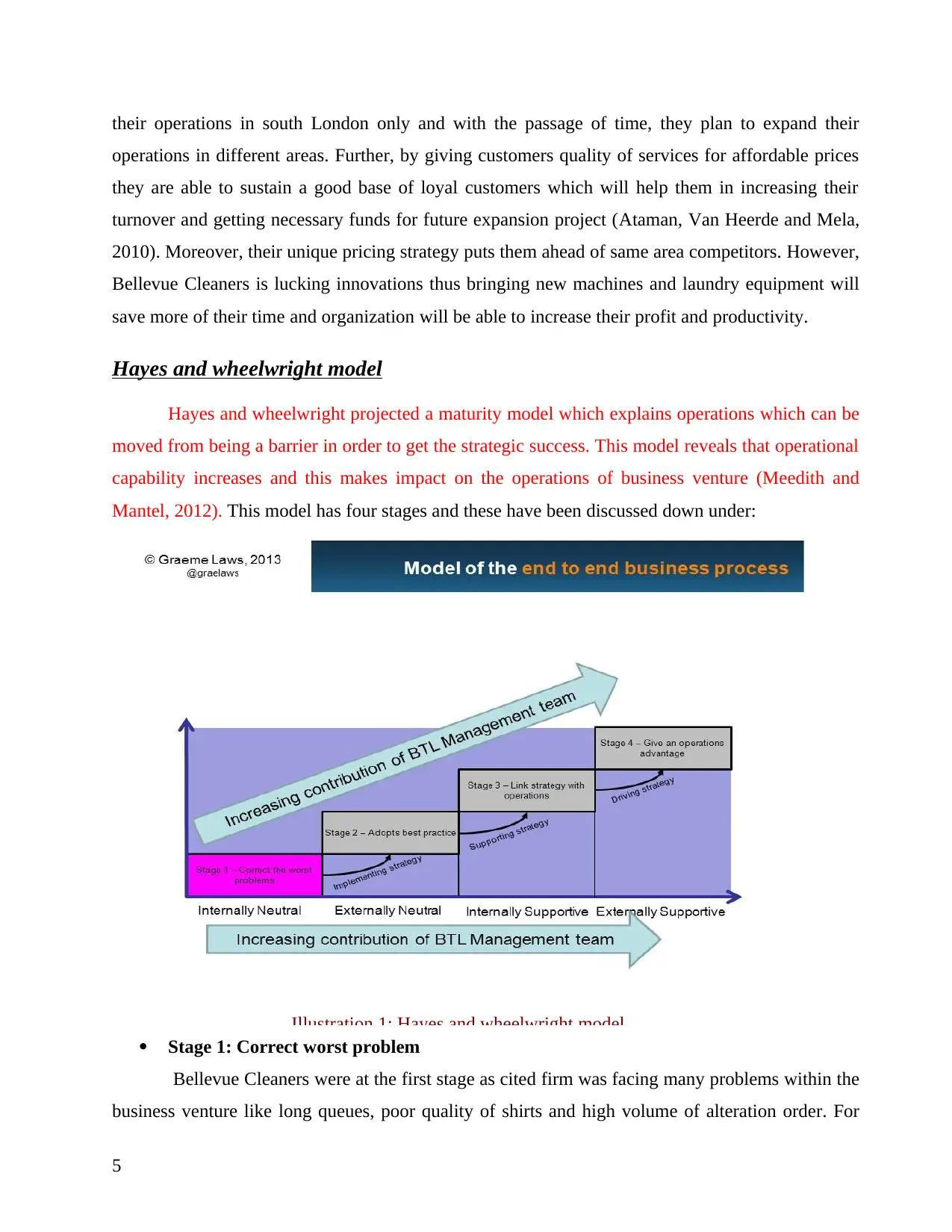
their operations in south London only and with the passage of time, they plan to expand their
operations in different areas. Further, by giving customers quality of services for affordable prices
they are able to sustain a good base of loyal customers which will help them in increasing their
turnover and getting necessary funds for future expansion project (Ataman, Van Heerde and Mela,
2010). Moreover, their unique pricing strategy puts them ahead of same area competitors. However,
Bellevue Cleaners is lucking innovations thus bringing new machines and laundry equipment will
save more of their time and organization will be able to increase their profit and productivity.
Hayes and wheelwright model
Hayes and wheelwright projected a maturity model which explains operations which can be
moved from being a barrier in order to get the strategic success. This model reveals that operational
capability increases and this makes impact on the operations of business venture (Meedith and
Mantel, 2012). This model has four stages and these have been discussed down under:
Illustration 1: Hayes and wheelwright model
Stage 1: Correct worst problem
Bellevue Cleaners were at the first stage as cited firm was facing many problems within the
business venture like long queues, poor quality of shirts and high volume of alteration order. For
5
operations in different areas. Further, by giving customers quality of services for affordable prices
they are able to sustain a good base of loyal customers which will help them in increasing their
turnover and getting necessary funds for future expansion project (Ataman, Van Heerde and Mela,
2010). Moreover, their unique pricing strategy puts them ahead of same area competitors. However,
Bellevue Cleaners is lucking innovations thus bringing new machines and laundry equipment will
save more of their time and organization will be able to increase their profit and productivity.
Hayes and wheelwright model
Hayes and wheelwright projected a maturity model which explains operations which can be
moved from being a barrier in order to get the strategic success. This model reveals that operational
capability increases and this makes impact on the operations of business venture (Meedith and
Mantel, 2012). This model has four stages and these have been discussed down under:
Illustration 1: Hayes and wheelwright model
Stage 1: Correct worst problem
Bellevue Cleaners were at the first stage as cited firm was facing many problems within the
business venture like long queues, poor quality of shirts and high volume of alteration order. For
5
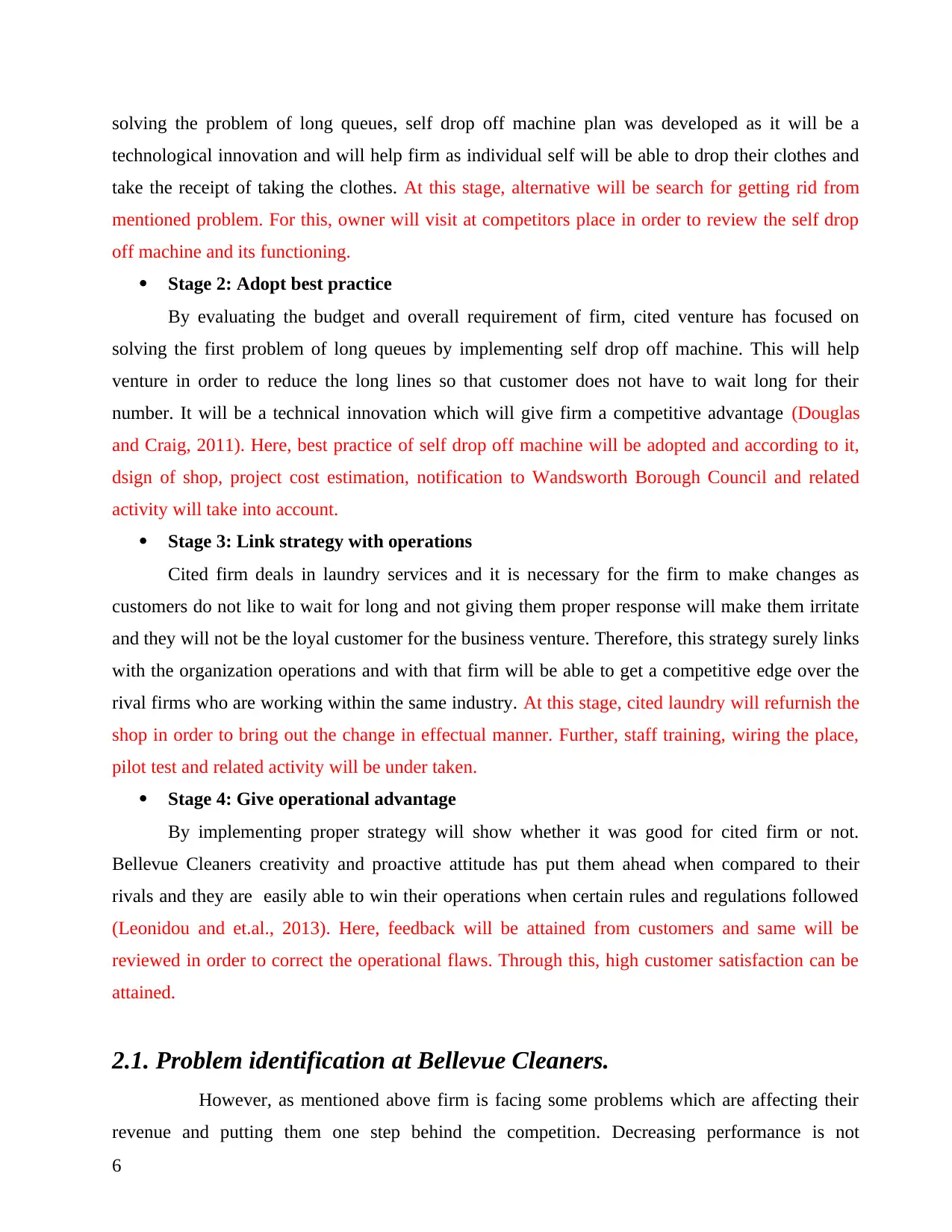
solving the problem of long queues, self drop off machine plan was developed as it will be a
technological innovation and will help firm as individual self will be able to drop their clothes and
take the receipt of taking the clothes. At this stage, alternative will be search for getting rid from
mentioned problem. For this, owner will visit at competitors place in order to review the self drop
off machine and its functioning.
Stage 2: Adopt best practice
By evaluating the budget and overall requirement of firm, cited venture has focused on
solving the first problem of long queues by implementing self drop off machine. This will help
venture in order to reduce the long lines so that customer does not have to wait long for their
number. It will be a technical innovation which will give firm a competitive advantage (Douglas
and Craig, 2011). Here, best practice of self drop off machine will be adopted and according to it,
dsign of shop, project cost estimation, notification to Wandsworth Borough Council and related
activity will take into account.
Stage 3: Link strategy with operations
Cited firm deals in laundry services and it is necessary for the firm to make changes as
customers do not like to wait for long and not giving them proper response will make them irritate
and they will not be the loyal customer for the business venture. Therefore, this strategy surely links
with the organization operations and with that firm will be able to get a competitive edge over the
rival firms who are working within the same industry. At this stage, cited laundry will refurnish the
shop in order to bring out the change in effectual manner. Further, staff training, wiring the place,
pilot test and related activity will be under taken.
Stage 4: Give operational advantage
By implementing proper strategy will show whether it was good for cited firm or not.
Bellevue Cleaners creativity and proactive attitude has put them ahead when compared to their
rivals and they are easily able to win their operations when certain rules and regulations followed
(Leonidou and et.al., 2013). Here, feedback will be attained from customers and same will be
reviewed in order to correct the operational flaws. Through this, high customer satisfaction can be
attained.
2.1. Problem identification at Bellevue Cleaners.
However, as mentioned above firm is facing some problems which are affecting their
revenue and putting them one step behind the competition. Decreasing performance is not
6
technological innovation and will help firm as individual self will be able to drop their clothes and
take the receipt of taking the clothes. At this stage, alternative will be search for getting rid from
mentioned problem. For this, owner will visit at competitors place in order to review the self drop
off machine and its functioning.
Stage 2: Adopt best practice
By evaluating the budget and overall requirement of firm, cited venture has focused on
solving the first problem of long queues by implementing self drop off machine. This will help
venture in order to reduce the long lines so that customer does not have to wait long for their
number. It will be a technical innovation which will give firm a competitive advantage (Douglas
and Craig, 2011). Here, best practice of self drop off machine will be adopted and according to it,
dsign of shop, project cost estimation, notification to Wandsworth Borough Council and related
activity will take into account.
Stage 3: Link strategy with operations
Cited firm deals in laundry services and it is necessary for the firm to make changes as
customers do not like to wait for long and not giving them proper response will make them irritate
and they will not be the loyal customer for the business venture. Therefore, this strategy surely links
with the organization operations and with that firm will be able to get a competitive edge over the
rival firms who are working within the same industry. At this stage, cited laundry will refurnish the
shop in order to bring out the change in effectual manner. Further, staff training, wiring the place,
pilot test and related activity will be under taken.
Stage 4: Give operational advantage
By implementing proper strategy will show whether it was good for cited firm or not.
Bellevue Cleaners creativity and proactive attitude has put them ahead when compared to their
rivals and they are easily able to win their operations when certain rules and regulations followed
(Leonidou and et.al., 2013). Here, feedback will be attained from customers and same will be
reviewed in order to correct the operational flaws. Through this, high customer satisfaction can be
attained.
2.1. Problem identification at Bellevue Cleaners.
However, as mentioned above firm is facing some problems which are affecting their
revenue and putting them one step behind the competition. Decreasing performance is not
6
⊘ This is a preview!⊘
Do you want full access?
Subscribe today to unlock all pages.

Trusted by 1+ million students worldwide
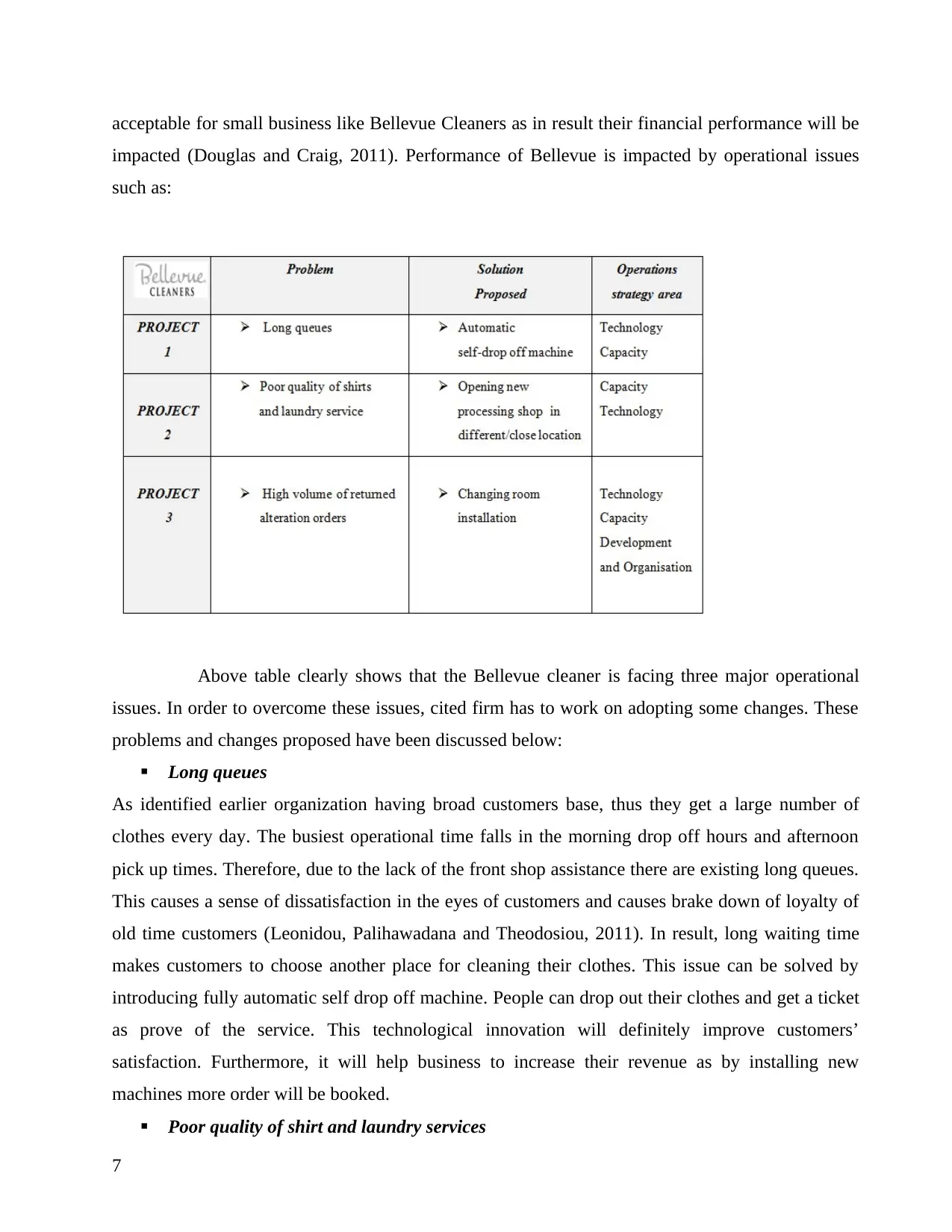
acceptable for small business like Bellevue Cleaners as in result their financial performance will be
impacted (Douglas and Craig, 2011). Performance of Bellevue is impacted by operational issues
such as:
Above table clearly shows that the Bellevue cleaner is facing three major operational
issues. In order to overcome these issues, cited firm has to work on adopting some changes. These
problems and changes proposed have been discussed below:
Long queues
As identified earlier organization having broad customers base, thus they get a large number of
clothes every day. The busiest operational time falls in the morning drop off hours and afternoon
pick up times. Therefore, due to the lack of the front shop assistance there are existing long queues.
This causes a sense of dissatisfaction in the eyes of customers and causes brake down of loyalty of
old time customers (Leonidou, Palihawadana and Theodosiou, 2011). In result, long waiting time
makes customers to choose another place for cleaning their clothes. This issue can be solved by
introducing fully automatic self drop off machine. People can drop out their clothes and get a ticket
as prove of the service. This technological innovation will definitely improve customers’
satisfaction. Furthermore, it will help business to increase their revenue as by installing new
machines more order will be booked.
Poor quality of shirt and laundry services
7
impacted (Douglas and Craig, 2011). Performance of Bellevue is impacted by operational issues
such as:
Above table clearly shows that the Bellevue cleaner is facing three major operational
issues. In order to overcome these issues, cited firm has to work on adopting some changes. These
problems and changes proposed have been discussed below:
Long queues
As identified earlier organization having broad customers base, thus they get a large number of
clothes every day. The busiest operational time falls in the morning drop off hours and afternoon
pick up times. Therefore, due to the lack of the front shop assistance there are existing long queues.
This causes a sense of dissatisfaction in the eyes of customers and causes brake down of loyalty of
old time customers (Leonidou, Palihawadana and Theodosiou, 2011). In result, long waiting time
makes customers to choose another place for cleaning their clothes. This issue can be solved by
introducing fully automatic self drop off machine. People can drop out their clothes and get a ticket
as prove of the service. This technological innovation will definitely improve customers’
satisfaction. Furthermore, it will help business to increase their revenue as by installing new
machines more order will be booked.
Poor quality of shirt and laundry services
7
Paraphrase This Document
Need a fresh take? Get an instant paraphrase of this document with our AI Paraphraser
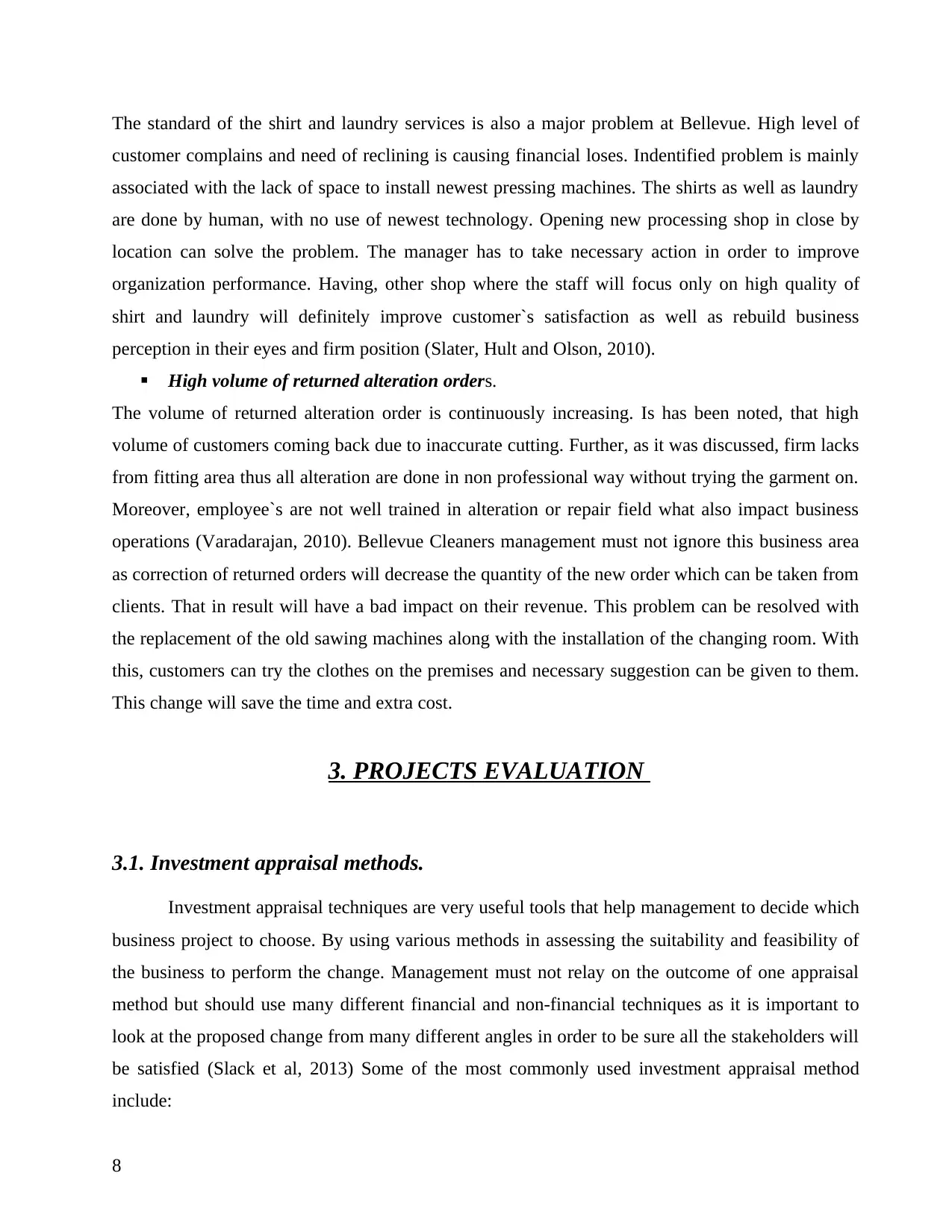
The standard of the shirt and laundry services is also a major problem at Bellevue. High level of
customer complains and need of reclining is causing financial loses. Indentified problem is mainly
associated with the lack of space to install newest pressing machines. The shirts as well as laundry
are done by human, with no use of newest technology. Opening new processing shop in close by
location can solve the problem. The manager has to take necessary action in order to improve
organization performance. Having, other shop where the staff will focus only on high quality of
shirt and laundry will definitely improve customer`s satisfaction as well as rebuild business
perception in their eyes and firm position (Slater, Hult and Olson, 2010).
High volume of returned alteration orders.
The volume of returned alteration order is continuously increasing. Is has been noted, that high
volume of customers coming back due to inaccurate cutting. Further, as it was discussed, firm lacks
from fitting area thus all alteration are done in non professional way without trying the garment on.
Moreover, employee`s are not well trained in alteration or repair field what also impact business
operations (Varadarajan, 2010). Bellevue Cleaners management must not ignore this business area
as correction of returned orders will decrease the quantity of the new order which can be taken from
clients. That in result will have a bad impact on their revenue. This problem can be resolved with
the replacement of the old sawing machines along with the installation of the changing room. With
this, customers can try the clothes on the premises and necessary suggestion can be given to them.
This change will save the time and extra cost.
3. PROJECTS EVALUATION
3.1. Investment appraisal methods.
Investment appraisal techniques are very useful tools that help management to decide which
business project to choose. By using various methods in assessing the suitability and feasibility of
the business to perform the change. Management must not relay on the outcome of one appraisal
method but should use many different financial and non-financial techniques as it is important to
look at the proposed change from many different angles in order to be sure all the stakeholders will
be satisfied (Slack et al, 2013) Some of the most commonly used investment appraisal method
include:
8
customer complains and need of reclining is causing financial loses. Indentified problem is mainly
associated with the lack of space to install newest pressing machines. The shirts as well as laundry
are done by human, with no use of newest technology. Opening new processing shop in close by
location can solve the problem. The manager has to take necessary action in order to improve
organization performance. Having, other shop where the staff will focus only on high quality of
shirt and laundry will definitely improve customer`s satisfaction as well as rebuild business
perception in their eyes and firm position (Slater, Hult and Olson, 2010).
High volume of returned alteration orders.
The volume of returned alteration order is continuously increasing. Is has been noted, that high
volume of customers coming back due to inaccurate cutting. Further, as it was discussed, firm lacks
from fitting area thus all alteration are done in non professional way without trying the garment on.
Moreover, employee`s are not well trained in alteration or repair field what also impact business
operations (Varadarajan, 2010). Bellevue Cleaners management must not ignore this business area
as correction of returned orders will decrease the quantity of the new order which can be taken from
clients. That in result will have a bad impact on their revenue. This problem can be resolved with
the replacement of the old sawing machines along with the installation of the changing room. With
this, customers can try the clothes on the premises and necessary suggestion can be given to them.
This change will save the time and extra cost.
3. PROJECTS EVALUATION
3.1. Investment appraisal methods.
Investment appraisal techniques are very useful tools that help management to decide which
business project to choose. By using various methods in assessing the suitability and feasibility of
the business to perform the change. Management must not relay on the outcome of one appraisal
method but should use many different financial and non-financial techniques as it is important to
look at the proposed change from many different angles in order to be sure all the stakeholders will
be satisfied (Slack et al, 2013) Some of the most commonly used investment appraisal method
include:
8
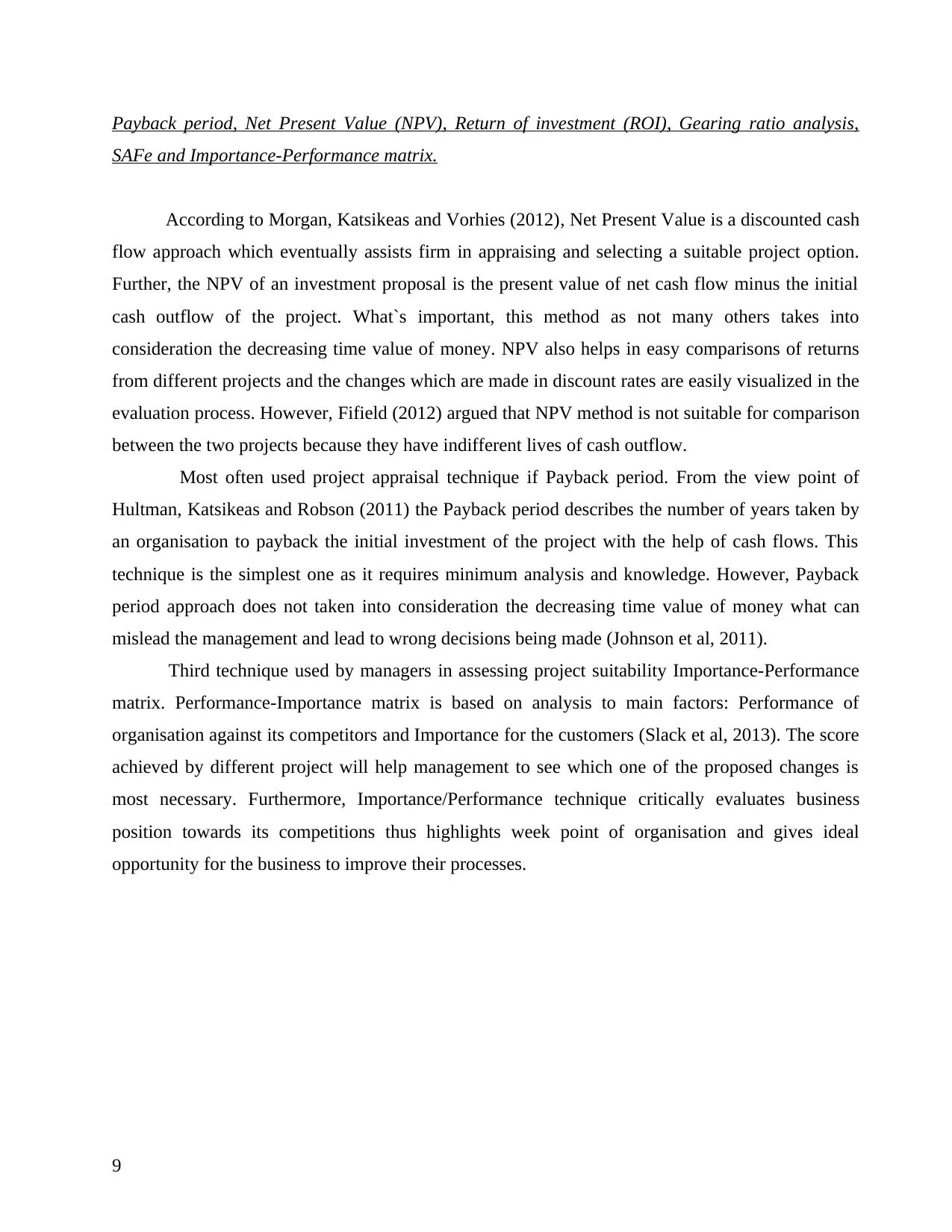
Payback period, Net Present Value (NPV), Return of investment (ROI), Gearing ratio analysis,
SAFe and Importance-Performance matrix.
According to Morgan, Katsikeas and Vorhies (2012), Net Present Value is a discounted cash
flow approach which eventually assists firm in appraising and selecting a suitable project option.
Further, the NPV of an investment proposal is the present value of net cash flow minus the initial
cash outflow of the project. What`s important, this method as not many others takes into
consideration the decreasing time value of money. NPV also helps in easy comparisons of returns
from different projects and the changes which are made in discount rates are easily visualized in the
evaluation process. However, Fifield (2012) argued that NPV method is not suitable for comparison
between the two projects because they have indifferent lives of cash outflow.
Most often used project appraisal technique if Payback period. From the view point of
Hultman, Katsikeas and Robson (2011) the Payback period describes the number of years taken by
an organisation to payback the initial investment of the project with the help of cash flows. This
technique is the simplest one as it requires minimum analysis and knowledge. However, Payback
period approach does not taken into consideration the decreasing time value of money what can
mislead the management and lead to wrong decisions being made (Johnson et al, 2011).
Third technique used by managers in assessing project suitability Importance-Performance
matrix. Performance-Importance matrix is based on analysis to main factors: Performance of
organisation against its competitors and Importance for the customers (Slack et al, 2013). The score
achieved by different project will help management to see which one of the proposed changes is
most necessary. Furthermore, Importance/Performance technique critically evaluates business
position towards its competitions thus highlights week point of organisation and gives ideal
opportunity for the business to improve their processes.
9
SAFe and Importance-Performance matrix.
According to Morgan, Katsikeas and Vorhies (2012), Net Present Value is a discounted cash
flow approach which eventually assists firm in appraising and selecting a suitable project option.
Further, the NPV of an investment proposal is the present value of net cash flow minus the initial
cash outflow of the project. What`s important, this method as not many others takes into
consideration the decreasing time value of money. NPV also helps in easy comparisons of returns
from different projects and the changes which are made in discount rates are easily visualized in the
evaluation process. However, Fifield (2012) argued that NPV method is not suitable for comparison
between the two projects because they have indifferent lives of cash outflow.
Most often used project appraisal technique if Payback period. From the view point of
Hultman, Katsikeas and Robson (2011) the Payback period describes the number of years taken by
an organisation to payback the initial investment of the project with the help of cash flows. This
technique is the simplest one as it requires minimum analysis and knowledge. However, Payback
period approach does not taken into consideration the decreasing time value of money what can
mislead the management and lead to wrong decisions being made (Johnson et al, 2011).
Third technique used by managers in assessing project suitability Importance-Performance
matrix. Performance-Importance matrix is based on analysis to main factors: Performance of
organisation against its competitors and Importance for the customers (Slack et al, 2013). The score
achieved by different project will help management to see which one of the proposed changes is
most necessary. Furthermore, Importance/Performance technique critically evaluates business
position towards its competitions thus highlights week point of organisation and gives ideal
opportunity for the business to improve their processes.
9
⊘ This is a preview!⊘
Do you want full access?
Subscribe today to unlock all pages.

Trusted by 1+ million students worldwide
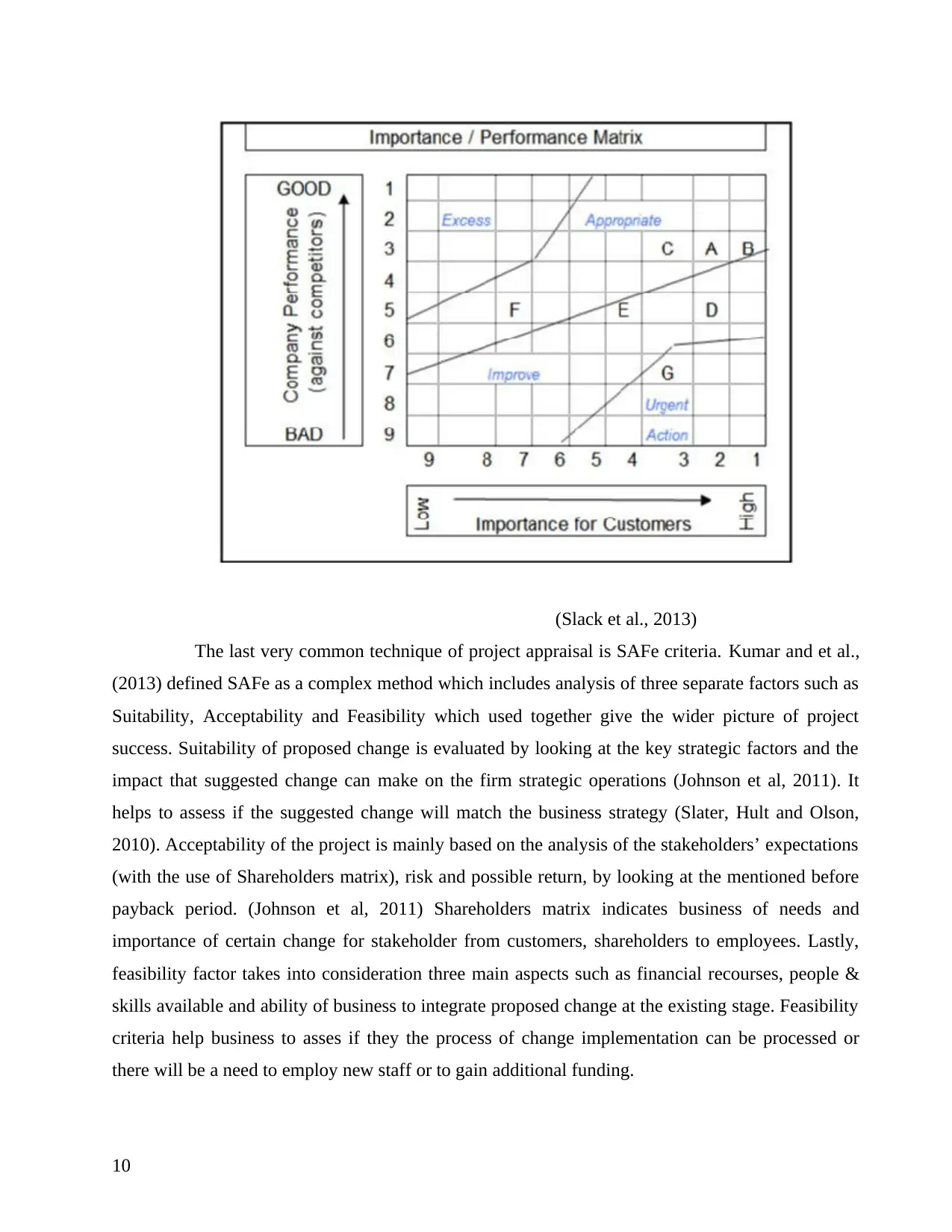
(Slack et al., 2013)
The last very common technique of project appraisal is SAFe criteria. Kumar and et al.,
(2013) defined SAFe as a complex method which includes analysis of three separate factors such as
Suitability, Acceptability and Feasibility which used together give the wider picture of project
success. Suitability of proposed change is evaluated by looking at the key strategic factors and the
impact that suggested change can make on the firm strategic operations (Johnson et al, 2011). It
helps to assess if the suggested change will match the business strategy (Slater, Hult and Olson,
2010). Acceptability of the project is mainly based on the analysis of the stakeholders’ expectations
(with the use of Shareholders matrix), risk and possible return, by looking at the mentioned before
payback period. (Johnson et al, 2011) Shareholders matrix indicates business of needs and
importance of certain change for stakeholder from customers, shareholders to employees. Lastly,
feasibility factor takes into consideration three main aspects such as financial recourses, people &
skills available and ability of business to integrate proposed change at the existing stage. Feasibility
criteria help business to asses if they the process of change implementation can be processed or
there will be a need to employ new staff or to gain additional funding.
10
The last very common technique of project appraisal is SAFe criteria. Kumar and et al.,
(2013) defined SAFe as a complex method which includes analysis of three separate factors such as
Suitability, Acceptability and Feasibility which used together give the wider picture of project
success. Suitability of proposed change is evaluated by looking at the key strategic factors and the
impact that suggested change can make on the firm strategic operations (Johnson et al, 2011). It
helps to assess if the suggested change will match the business strategy (Slater, Hult and Olson,
2010). Acceptability of the project is mainly based on the analysis of the stakeholders’ expectations
(with the use of Shareholders matrix), risk and possible return, by looking at the mentioned before
payback period. (Johnson et al, 2011) Shareholders matrix indicates business of needs and
importance of certain change for stakeholder from customers, shareholders to employees. Lastly,
feasibility factor takes into consideration three main aspects such as financial recourses, people &
skills available and ability of business to integrate proposed change at the existing stage. Feasibility
criteria help business to asses if they the process of change implementation can be processed or
there will be a need to employ new staff or to gain additional funding.
10
Paraphrase This Document
Need a fresh take? Get an instant paraphrase of this document with our AI Paraphraser
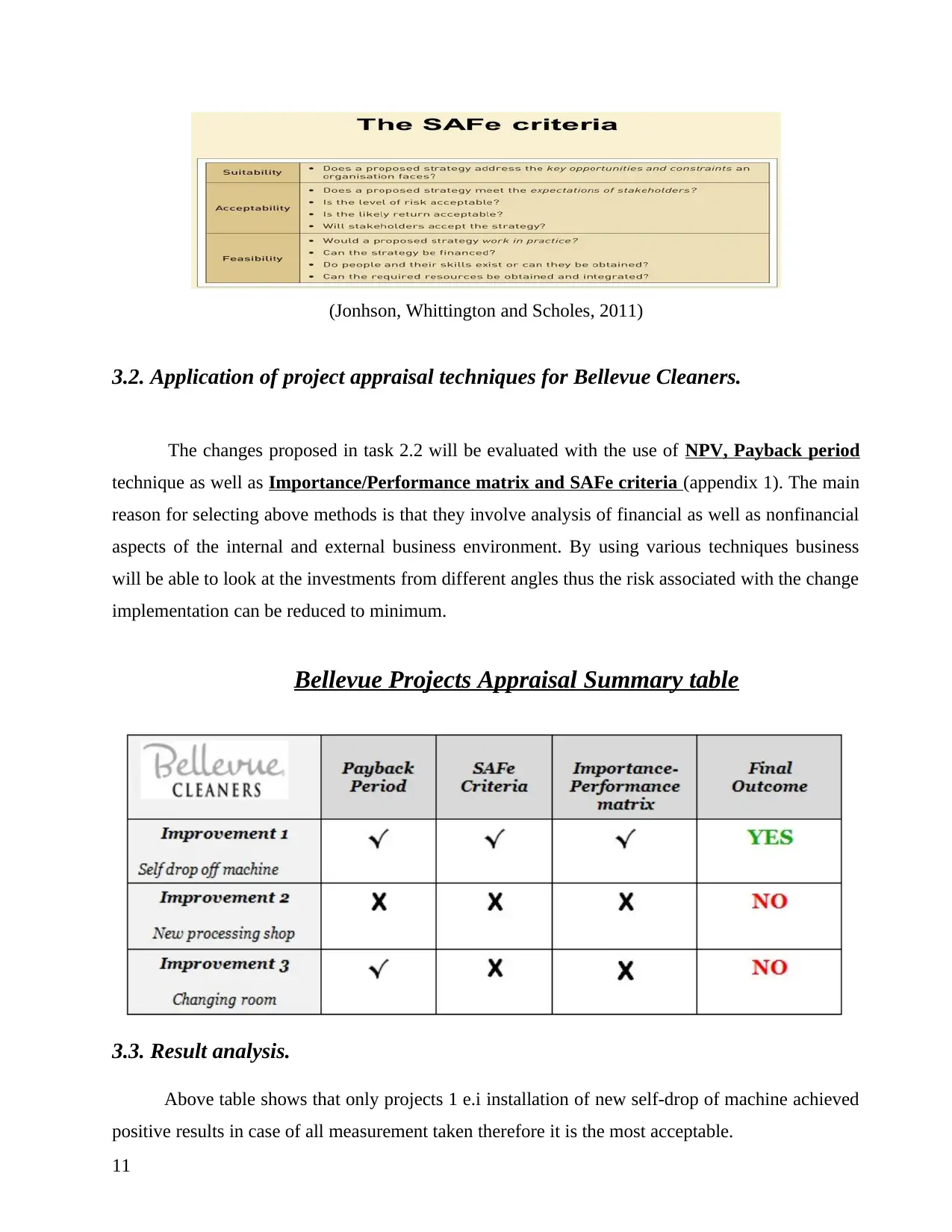
(Jonhson, Whittington and Scholes, 2011)
3.2. Application of project appraisal techniques for Bellevue Cleaners.
The changes proposed in task 2.2 will be evaluated with the use of NPV, Payback period
technique as well as Importance/Performance matrix and SAFe criteria (appendix 1). The main
reason for selecting above methods is that they involve analysis of financial as well as nonfinancial
aspects of the internal and external business environment. By using various techniques business
will be able to look at the investments from different angles thus the risk associated with the change
implementation can be reduced to minimum.
Bellevue Projects Appraisal Summary table
3.3. Result analysis.
Above table shows that only projects 1 e.i installation of new self-drop of machine achieved
positive results in case of all measurement taken therefore it is the most acceptable.
11
3.2. Application of project appraisal techniques for Bellevue Cleaners.
The changes proposed in task 2.2 will be evaluated with the use of NPV, Payback period
technique as well as Importance/Performance matrix and SAFe criteria (appendix 1). The main
reason for selecting above methods is that they involve analysis of financial as well as nonfinancial
aspects of the internal and external business environment. By using various techniques business
will be able to look at the investments from different angles thus the risk associated with the change
implementation can be reduced to minimum.
Bellevue Projects Appraisal Summary table
3.3. Result analysis.
Above table shows that only projects 1 e.i installation of new self-drop of machine achieved
positive results in case of all measurement taken therefore it is the most acceptable.
11
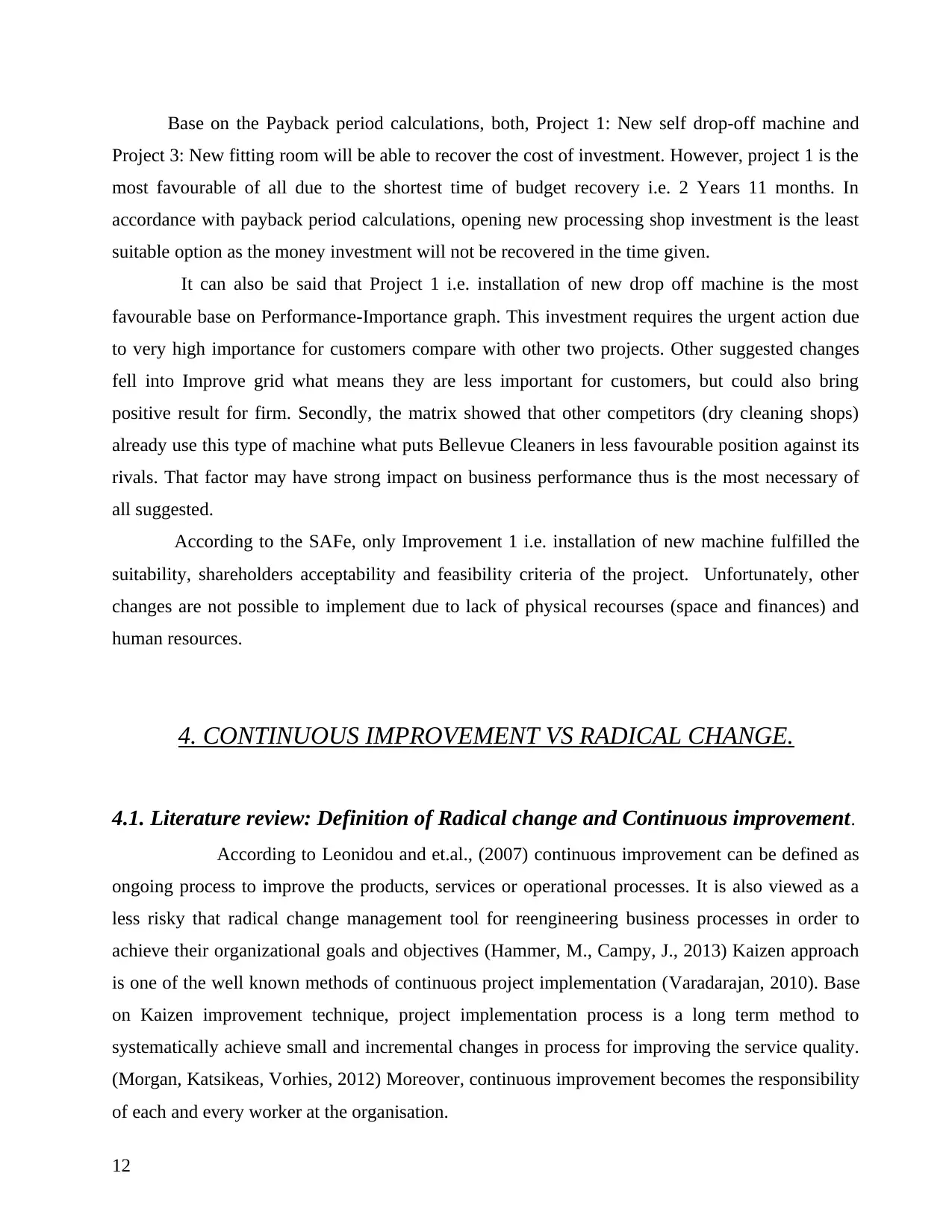
Base on the Payback period calculations, both, Project 1: New self drop-off machine and
Project 3: New fitting room will be able to recover the cost of investment. However, project 1 is the
most favourable of all due to the shortest time of budget recovery i.e. 2 Years 11 months. In
accordance with payback period calculations, opening new processing shop investment is the least
suitable option as the money investment will not be recovered in the time given.
It can also be said that Project 1 i.e. installation of new drop off machine is the most
favourable base on Performance-Importance graph. This investment requires the urgent action due
to very high importance for customers compare with other two projects. Other suggested changes
fell into Improve grid what means they are less important for customers, but could also bring
positive result for firm. Secondly, the matrix showed that other competitors (dry cleaning shops)
already use this type of machine what puts Bellevue Cleaners in less favourable position against its
rivals. That factor may have strong impact on business performance thus is the most necessary of
all suggested.
According to the SAFe, only Improvement 1 i.e. installation of new machine fulfilled the
suitability, shareholders acceptability and feasibility criteria of the project. Unfortunately, other
changes are not possible to implement due to lack of physical recourses (space and finances) and
human resources.
4. CONTINUOUS IMPROVEMENT VS RADICAL CHANGE.
4.1. Literature review: Definition of Radical change and Continuous improvement.
According to Leonidou and et.al., (2007) continuous improvement can be defined as
ongoing process to improve the products, services or operational processes. It is also viewed as a
less risky that radical change management tool for reengineering business processes in order to
achieve their organizational goals and objectives (Hammer, M., Campy, J., 2013) Kaizen approach
is one of the well known methods of continuous project implementation (Varadarajan, 2010). Base
on Kaizen improvement technique, project implementation process is a long term method to
systematically achieve small and incremental changes in process for improving the service quality.
(Morgan, Katsikeas, Vorhies, 2012) Moreover, continuous improvement becomes the responsibility
of each and every worker at the organisation.
12
Project 3: New fitting room will be able to recover the cost of investment. However, project 1 is the
most favourable of all due to the shortest time of budget recovery i.e. 2 Years 11 months. In
accordance with payback period calculations, opening new processing shop investment is the least
suitable option as the money investment will not be recovered in the time given.
It can also be said that Project 1 i.e. installation of new drop off machine is the most
favourable base on Performance-Importance graph. This investment requires the urgent action due
to very high importance for customers compare with other two projects. Other suggested changes
fell into Improve grid what means they are less important for customers, but could also bring
positive result for firm. Secondly, the matrix showed that other competitors (dry cleaning shops)
already use this type of machine what puts Bellevue Cleaners in less favourable position against its
rivals. That factor may have strong impact on business performance thus is the most necessary of
all suggested.
According to the SAFe, only Improvement 1 i.e. installation of new machine fulfilled the
suitability, shareholders acceptability and feasibility criteria of the project. Unfortunately, other
changes are not possible to implement due to lack of physical recourses (space and finances) and
human resources.
4. CONTINUOUS IMPROVEMENT VS RADICAL CHANGE.
4.1. Literature review: Definition of Radical change and Continuous improvement.
According to Leonidou and et.al., (2007) continuous improvement can be defined as
ongoing process to improve the products, services or operational processes. It is also viewed as a
less risky that radical change management tool for reengineering business processes in order to
achieve their organizational goals and objectives (Hammer, M., Campy, J., 2013) Kaizen approach
is one of the well known methods of continuous project implementation (Varadarajan, 2010). Base
on Kaizen improvement technique, project implementation process is a long term method to
systematically achieve small and incremental changes in process for improving the service quality.
(Morgan, Katsikeas, Vorhies, 2012) Moreover, continuous improvement becomes the responsibility
of each and every worker at the organisation.
12
⊘ This is a preview!⊘
Do you want full access?
Subscribe today to unlock all pages.

Trusted by 1+ million students worldwide
1 out of 46
Related Documents
Your All-in-One AI-Powered Toolkit for Academic Success.
+13062052269
info@desklib.com
Available 24*7 on WhatsApp / Email
![[object Object]](/_next/static/media/star-bottom.7253800d.svg)
Unlock your academic potential
Copyright © 2020–2025 A2Z Services. All Rights Reserved. Developed and managed by ZUCOL.




